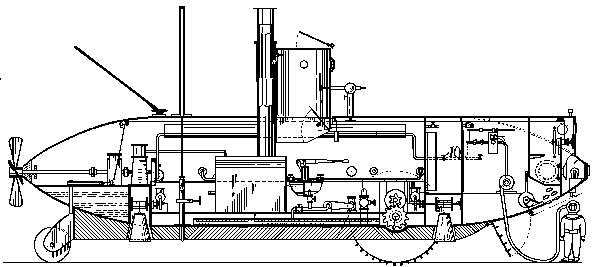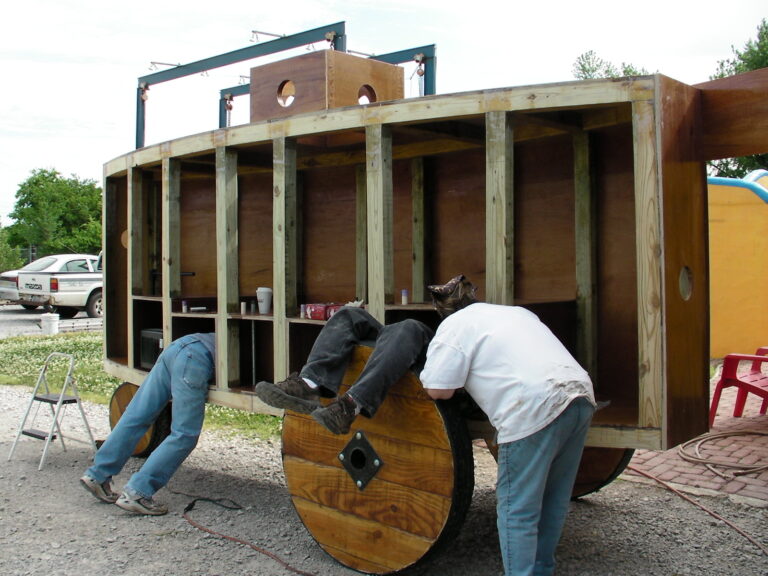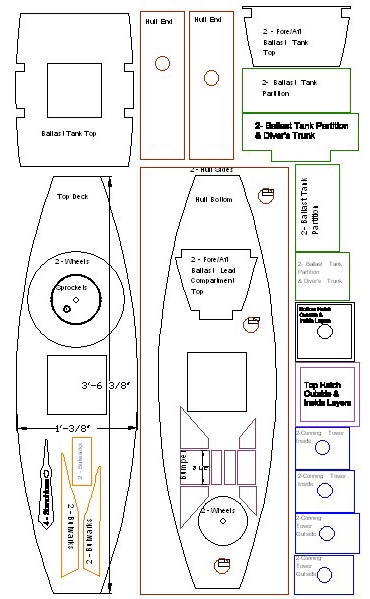The thing about submarines is they are heavy. And the bigger they are the heavier they fall. But it’s easy to sink a boat, right? Yes, but only if you’re willing to fill it with water. Sinking a boat with 227 cubic feet of air inside means that the boat must weight MORE than the 227 cubic feet of water. In our case, a 7 ton boat means 7 tons of water! To make the boat heavy enough to sink you need ballast and our choices were concrete, steel, or lead. We also built in some tanks to be flooded with water. It’s the water in those tanks that will tip the scales and allow the submarine to slip under the surface with her precious cargo of air. That means two types of ballast, “ballast weights” and “ballast tanks”.
Ballast Weight
We calculated that 5 tons of ballast weight is needed in addition to get the submarine to sink after 35 cubic feet of water floods into the ballast tanks. Five tons is 10,000 pounds or about the weight of two medium sedans.


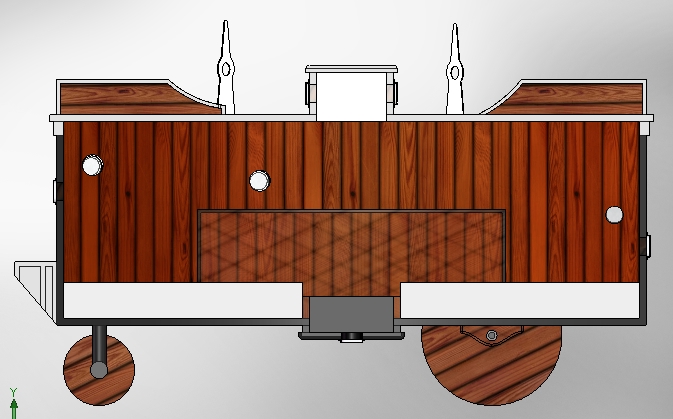
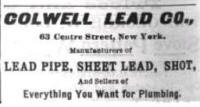
Concrete or Iron or Lead
Simon had all of these available to him for ballast weight. Concrete is the least expensive, but 5 tons of concrete takes up too much space as it only weighs about 150 pounds for each cubic foot. The water being pushed aside weighs 62.4 pounds per cubic foot, so you’d need almost 1 cubic ft of concrete for every 2 cubic feet of air to take down. That’s not going to leave much room inside.
So what about steel? A cubic foot of steel weighs 490 pounds and will drag down more than 7 cubic feet of air. But even better is lead as it weighs a whopping 708 pounds per cubic foot!
The lead will need to be added to Argonaut Jr. after it is in the water because the wooden wheels will never take the 5 tons of extra weight. So the lead must be fit in around the ballast tanks and the divers hatch in the bottom. And it will be set in as bricks so it can be moved a little at a time in and out of the hatch.
Anchors
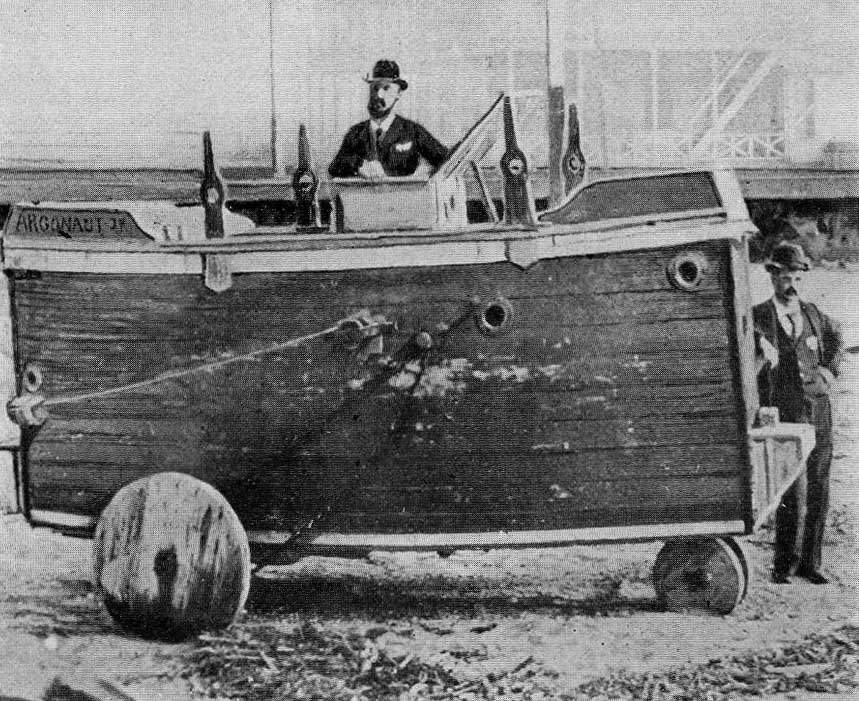
Bow and stern anchors hung on each end of the Argonaut and were either lowered by capstans near the center of the boat or lowered from the capstans and just swung up over cleats at the bow and stern. Either way these anchors could be lowered to the bottom, allowing the Argonaut Jr. to rise off the bottom and give a diver room to clear the bottom of the sub when moving thought the bottom hatch. These anchors also make up some to the ballast weight on Argonaut Jr.
We made them adjustable so different configurations could be tested. We made lead anchors that can have 20+ lb disc added as needed. The top of the anchor was a cone shaped lead cast around an eye bolt that we could tie onto and also cast around a piece of all thread that sticks down so adding or removing discs from the stack are a breeze. Each anchor weighed about 125 pounds or 250 pounds altogether.
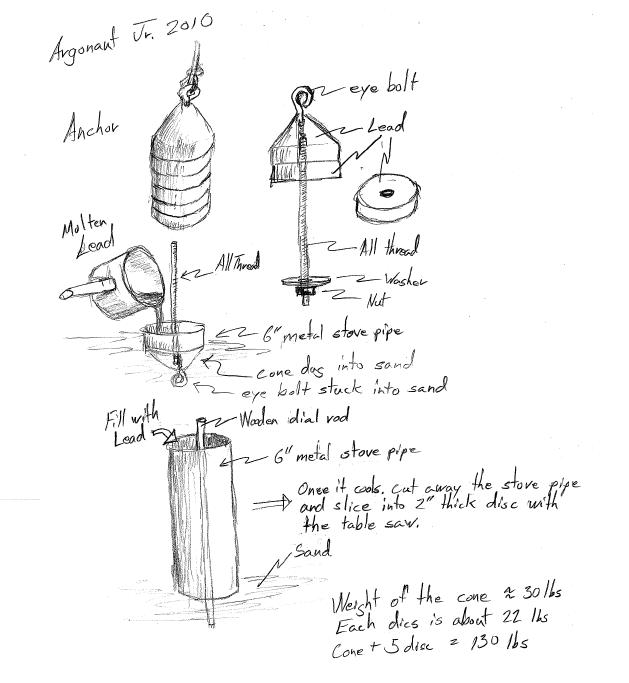
Drop Weights
Getting back to the surface is important. The submarine may be taking on water or the air supply could fail and prevents us from blowing the water out of the ballast tanks. For those emergencies we use drop weights. A drop weight is just something heavy that you can through overboard and make your boat lighter. The anchors are two obvious drop weights. If we lower then all the way then the rope can let go from the winch, allowing the anchors to fall to the bottom. If the submarine is ambient and the divers hatch can be opened then we can simply lift additional weight from the floor and drop them out the hatch. Finally additional drop weights will be installed between the wooded frames below the floor. Turning a handle inside the submarine will move a latch below these weights and allow them to fall free, immediately making the submarine 3,100 pounds lighter.
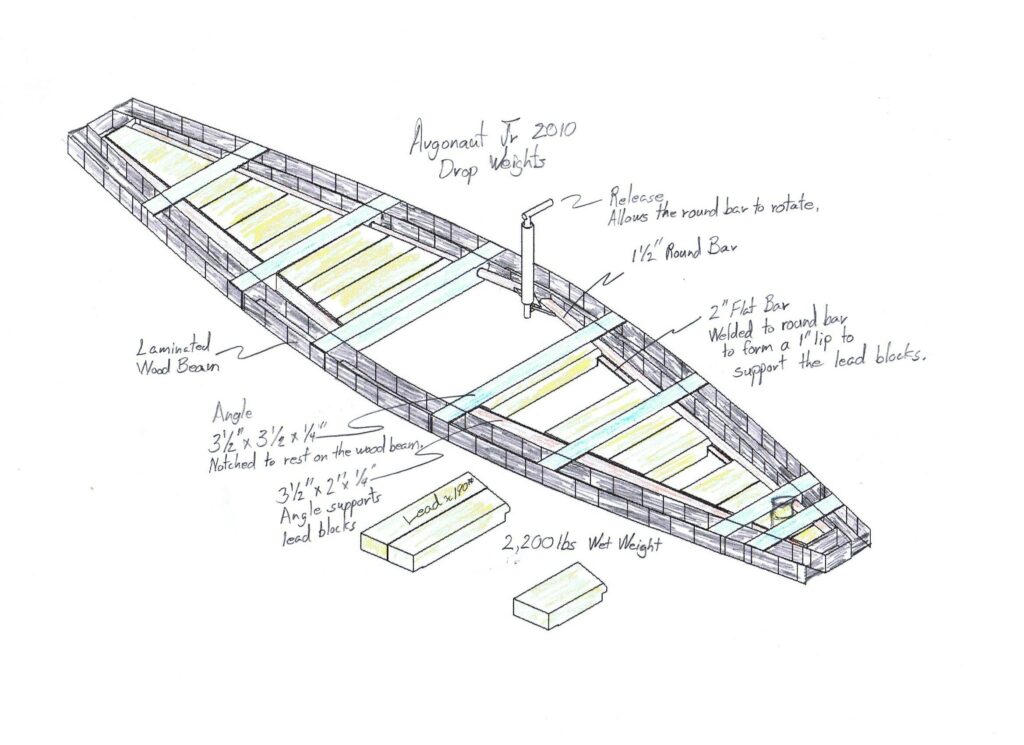

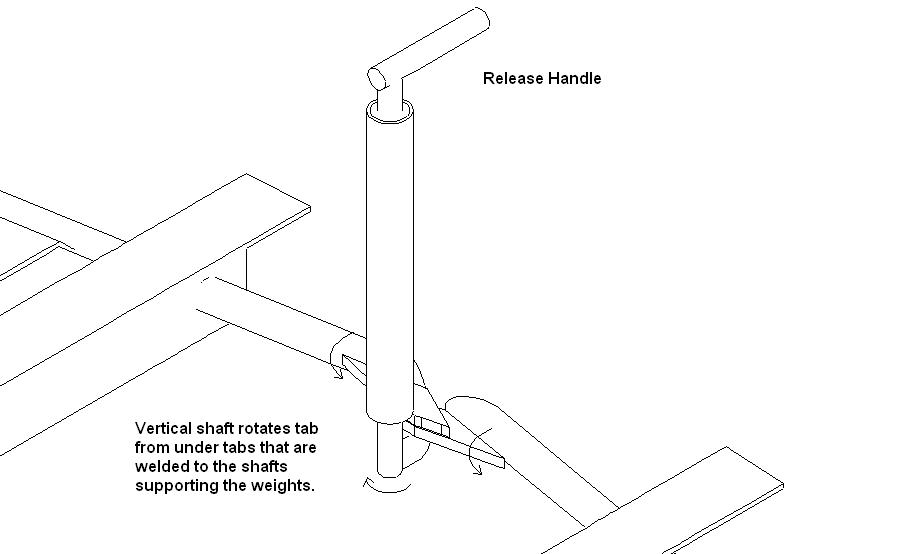
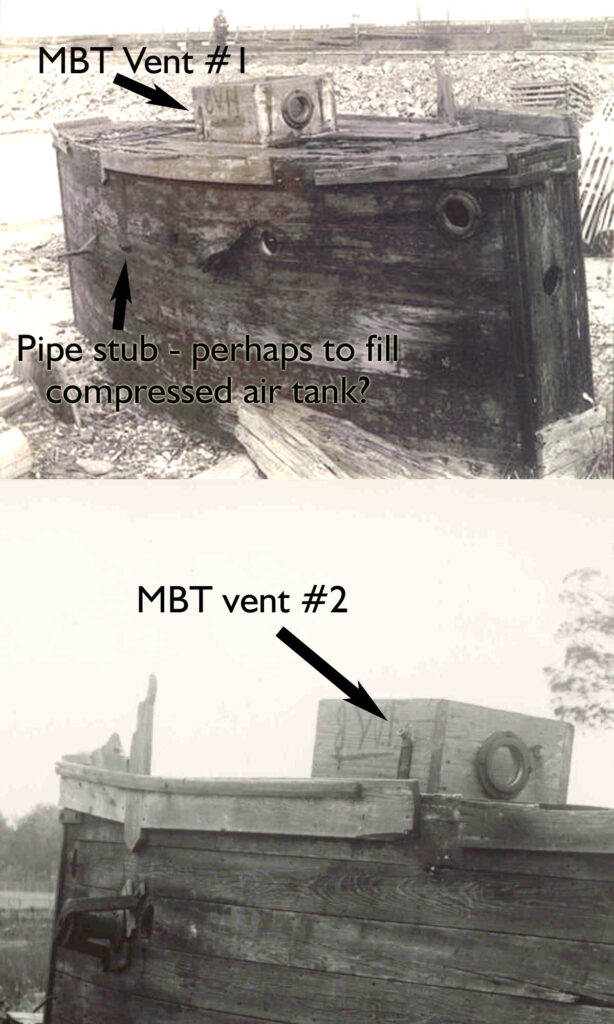
Ballast Tanks
We don’t know exactly where Simon put the ballast tanks inside the Argonaut Jr., but we can see the plumbing that would have vented the tanks so they could flood. Both sides of the top hatch trunk have pipes that likely connected to a ballast tank. When the vents were opened, another valve in the floor would have been opened to allow water to flood into the ballast tanks. When the boat is heavy enough to slowly sink, the valves would be closed.
If the anchors were hanging below the boat then they would have touched bottom first. Once the anchors were sitting on the bottom, they would no longer be pulling the Argonaut Jr. down, so the boat may have then floated off the bottom by its anchor ropes. This would have given a diver plenty of room to slip out the bottom hatch onto the ocean without having to crawl out from under the submarine.
When Simon wanted to roll the Argonaut across the bottom, he would simply raise the anchors so the wheels took on their weight. On the bottom the Argonaut Jr. would have only weighed a hundred pounds or so. The weight could be increased by adding more water to the ballast tanks, or by blowing water out the bottom of the tanks using the air stored in the air tank.
Ballast Tank Size and Freeboard
It’s all about trade-offs. The bigger you make the ballast tanks, the higher you are out of the water when they’re empty. The height out of the water is called “freeboard”. The more freeboad the better, because it keeps waves from pouring into the submarine when you have the hatch open on the surface. But the bigger you make the tanks, the less room you have for crew and equipment inside the submarine. After you bang your head a few times you will start wishing you had more room.
1/4 Scale Model Ballast Testing
We built a scale model which allowed us to also test the displacement, freeboard, and ballast weight calculations.
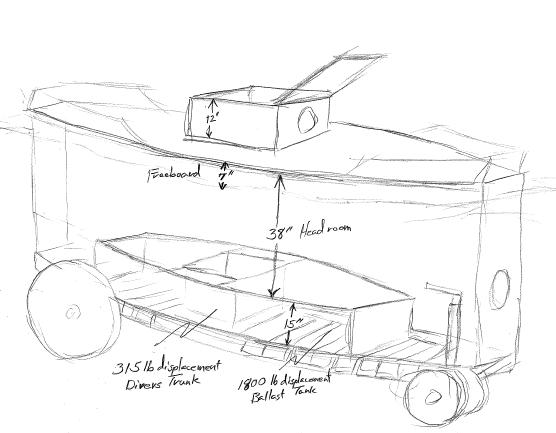
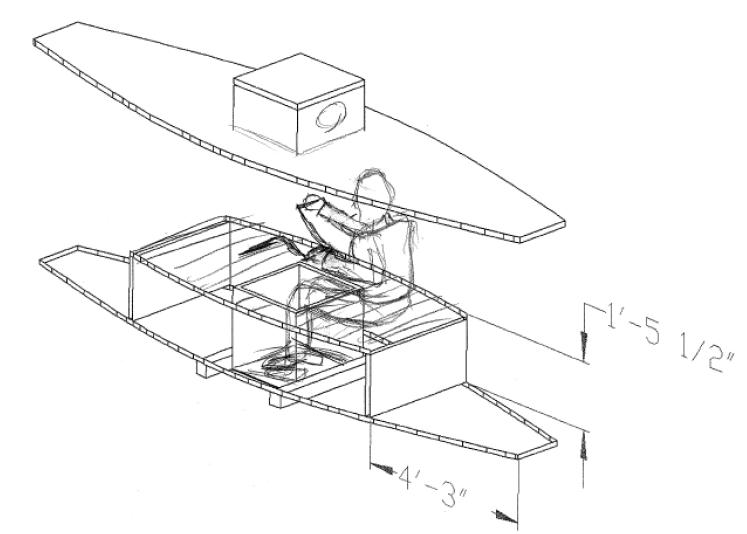
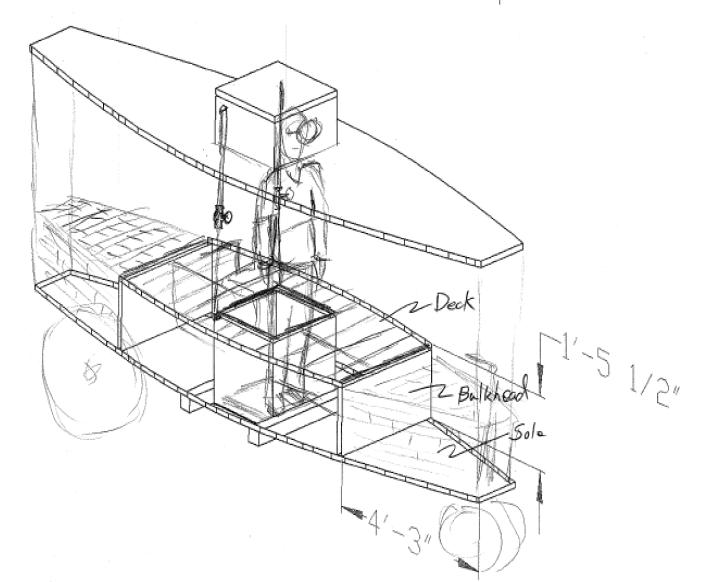
Scuba dooba do…WWSD (what would Simon do)

The Scuba tanks the regulator used in Argonaut Jr. 2010
were not invented until 1942 by Emile Gagnan and Jacques
Cousteau.
Instead, Simon scrounged for his tank and compressor: “… our compressed-air reservoir was a tank from a bankrupt soda-fountain, and the pump for
compressing air had begun life as a plumber’s hand-pump.”

Our solution was a bit easier. I took an old regulator apart and rigged it by putting the diaphragm on the end of a pipe with a float inside. The float could extend to the bottom of the sub and would transfer the psi at the bottom of the hull to the valve which would be 18 inches higher in Argonaut’s case. We could have one on each side and that would give us 60 cfm which would be more than enough. The descent speed is controlled by how fast you crank the submarine down to the bottom where the anchors would be sitting.
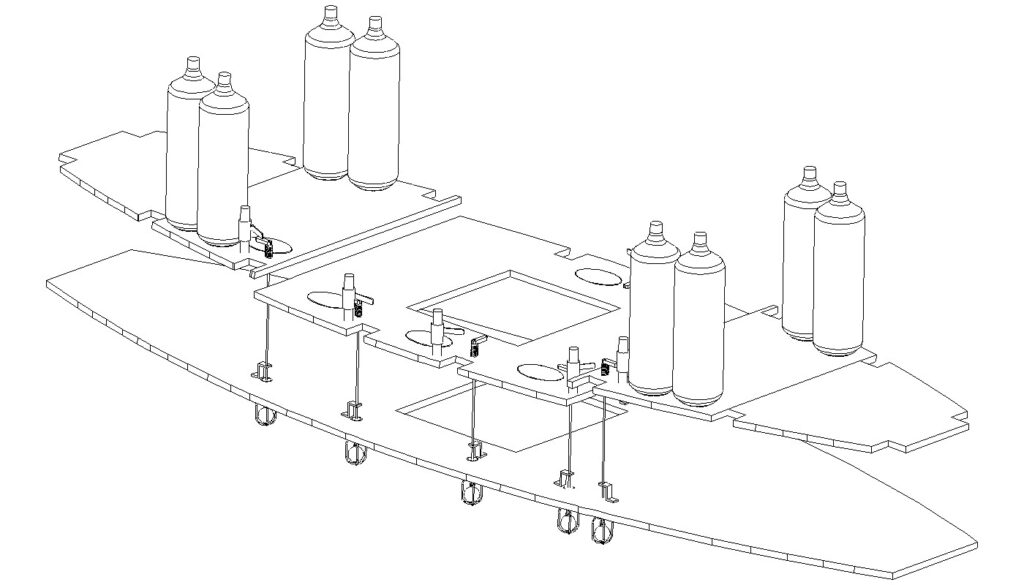
Ballast Tank Control Valves
The valves in the top of the ballast tanks are used to fill and release air and they are common PVC ball valves. The valves in the bottom of the tank are more complicated. For most dives they will be locked open, allowing the water to enter and leave the tanks when air is vented or forced into the tanks. But they will be closed when back on the surface. The ballast tanks are below the water line even when the Argonaut Jr. is on the surface. So having them closed allows for the air pressure in the tanks to be release without water flooding in through the bottom. This allows for the tank to leak or for work to be done through the inspection hatch with the submarine still in the water. It also lets almost all of the water to be expelled from the tank so the wood has a chance to dry out. These bottom “flood valves” must also act as check valves; automatically opening to let excess pressure inside the tank to vent safely into the water. The air system will have about 150 psi of pressure above the pressure inside the sub, so if a ballast tank was pressurized to force the water out with the bottom valve accidentally left closed, the pressure would be enough to cause the tank to explode.
Occasionally you may want to close the bottom valves during a dive. This is a dangerous procedure if not closely monitored but it has advantages. A ballast tank that is left open at the bottom is called a “soft tank”. Soft tanks on submarines are commonly completely flooded with water during dives. If a portion of the tank had air remaining inside, the air would compress as the submarine descended and as the air compressed the submarine would lose some of it’s displacement and sink faster. So in order to trim a submarine we want “hard tanks”. A hard tank can have some air left inside in order to easily adjust the submarine’s displacement as needed. If the submarine’s displacement is adjusted so that it is just slightly negative then it will slowly sink deeper. Slowly changing depth is important for an ambient submarine because time is needed for additional air to flow into the cabin and for the passengers to equalize their ears to the change in pressure. With the valves in the bottom of the ballast tanks, the Argonaut Jr. will be able to add air as needed to the tanks in order to adjust the submarines displacement and then close the bottom flood valves so the pressure inside the ballast tank and the volume of air tapped does not change as the submarine descends. The danger is that the pressure of the air inside the submarine and the water outside the submarine will become too much for the tank and the tank will implode. To avoid this, only the two smaller ballast tanks on either side of the divers trunk should be used as hard tanks and the submarine should not descend more than 20 feet after closing the flood valves.
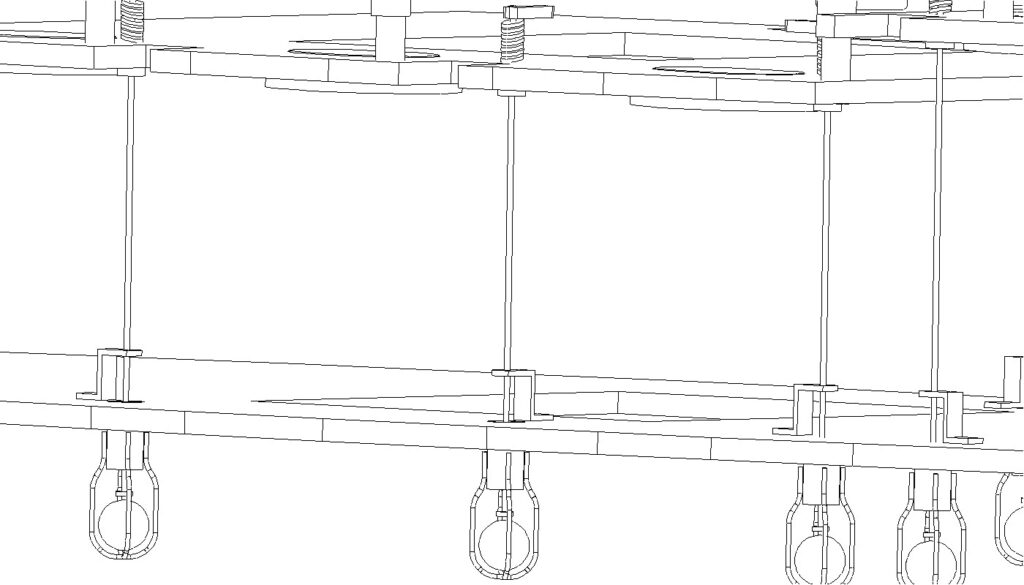

Slow descents can easily be done in the Argonaut Jr. without using the hard tanks. To do some the boat is simply trimmed so that it still has 50 to 100 pounds of negative buoyancy when the ballast tanks are completely flooded. To trim the boat in this manner it will be necessary to add up the weight of the passengers and add or remove some of the lead weight ballast as needed. To submerge the submarine the fist step is to lower the two anchors until they are sitting on the bottom. That will make the boat 200 pound lighter. Then flood all of the ballast tanks. The boat would now normally be 50 to 100 pounds heavier than it’s displacement and begin to sink, however it will remain on the surface with just a little of the conning tower out of the water. The reason is that anchors that weigh over 200 pounds are on the bottom an not weighing down the boat. Now you only need to turn the cranks to pull in the anchor rode, that’s “rope” to you land lubbers. Because the anchors are 200 pounds and the submarine has less than 100 pounds of positive buoyancy; the anchors will stay on the bottom and the submarine will descend only as fast as you wind in the line.
Ballast Weight Calculations
The numbers below are estimates and the actual numbers have turned out better, as hoped, because we tried to be concretive in our estimates. For example we calculated the weight of the hull without accounting for the 60 gallons of epoxy we used to make it waterproof. And we built the steel structure of the drop weight out of much heavier than needed steel. So our estimated 1,482 pound for the hull actually came out to 2,560 pounds. That means we need less lead ballast. And our estimated 3,102 pounds for the drop weights turned out to be 3,633 pounds or 528 pounds over the estimate. Another good thing as it reduces the amount of lead required inside the hull by 1,660 pounds, so instead of 7,353 pounds, we only need 6,803 pounds inside.
| Argonaut Jr. 2010 – Buoyancy Calculations – Version #4 | ||||
| Water Weight | 0.0361 | Lbs/Cubic In | ||
| Marine Plywood Weight | 0.0187 | Lbs/Cubic In | ||
| Lead Weight | 0.3520 | Lbs/Cubic In | ||
| Displacement | Positive | Negative | ||
| Main Body Horizontal Cross Section Area | 6655.00 | Sq In | ||
| Height, Bottom to Deck | 57.50 | Inches | ||
| Main Body Volume | 382662.50 | Cubic In | ||
| Conning Tower & Divers Trunk Below Hull Bottom Vol | 10656.00 | Cubic In | ||
| Total Body Volume | 393318.50 | Cubic In | ||
| Total Body Displacement (Vol x Water Weight) | 14198.80 | Lbs | 14198.80 | |
| Plywood Volume, Hull Sides (3/4″) | 17280.00 | Cubic In | ||
| Plywood Volume, Everything Else (1″) | 29744.50 | Cubic In | ||
| Interior Wood Beams | 16149.00 | Cubic In | ||
| Total Interior Wood Volume | 63173.50 | Cubic In | ||
| Hull Wood Weight | 1182.68 | Lbs | 1182.68 | |
| Exterior Framing/Wheels Positive Displacement | 246.61 | Lbs | 246.61 | |
| Axel & Steering Hardware | 200.00 | Lbs | 200.00 | |
| Ballast Tank Area – Sides | 522.00 | Sq In | ||
| Ballast Tank Area – Forward & Aft Tanks | 3536.00 | Sq In | ||
| Ballast Tank Height | 15.00 | In | ||
| Head Room | 39.50 | In | ||
| Ballast Tank Volume | 60870.00 | Cubic In | ||
| Tank Displacement | 2197.41 | Lbs | 2197.41 | |
| Anchors | 250.00 | Lbs | 250.00 | |
| Passengers | 400.00 | Lbs | 400.00 | |
| Scuba Tanks (6) | 210.00 | Lbs | 210.00 | |
| Other Hardware and Equipment | 75.00 | Lbs | 75.00 | |
| Ballast Weight (Lead) | 10140.00 | Lbs | 10140.00 | |
| 14445.40 | 14655.08 | |||
| Drop Weight and Internal Weights | ||||
| Lead Drop Weight Volume | 8821.61 | Cubic In | ||
| Lead Drop Weight Mass | 3105.21 | Lbs | ||
| Lead Drop Weight Mass (Less Displacement) | 2786.75 | Lbs | ||
| Lead Required Inside | 7353.25 | Lbs | ||
| Interior Lead Volume | 20889.92 | Cubic In | ||
| Lead Floor Area | 1440.00 | Sq In | ||
| Lead Height from Floor | 14.51 | In | ||
| Divers Trunk | ||||
| Divers Trunk Volume | 8712.00 | Cubic In | ||
| Divers Trunk Displacement | 314.50 | Lbs | ||
| Freeboard | ||||
| Ballast Tanks | 66120.00 | Cubic In | ||
| Conning Tower | 10656.00 | Sq In | ||
| Main Body Horizontal Cross Section Area | 6655.00 | Sq In | ||
| Main Body Freeboard (Tanks – CT / Cross Section) | 8.33 | In | ||
| Air Consumption | Cubic Inches | Cubic Feet | ||
| Total Interior Volume | 393318.50 | 227.61 | ||
| Ballast Tanks Volume | 60870.00 | 35.23 | ||
| Interior Lead Ballast Weight Volume | 20889.92 | 12.09 | ||
| Interior Framing Volume | 63173.50 | 36.56 | ||
| Crew and Equipment (Estimated) | 20000.00 | 11.57 | ||
| Interior Air Volume | 228385.08 | 132.17 | ||
| Model | Required | Actual | ||
| Interior Pounds | 114.89 | 104.55 | ||
| Exterior Pounds | 48.52 | 48.95 | ||
| Wood | 18.48 | 16.00 | ||
| Expoy and Glue | 7.00 | |||
| Total | 181.89 | 176.50 | ||
| Corrections | ||||
| Fixed Ballast Difference | 9.91 | |||
| Additional Displacement | 4.00 | |||
| Crew and Equipment | 14.61 | |||
| Lighter Wood | 0.30 | |||
| Total Lead to Add to Interior | 28.82 | |||
Facts We Need To Know
Modern regulators have a maximum flow rate of 30+ cubic feet per minute @3000 psi
An 80 cubic foot scuba tank only holds about 77 cubic feet.
Scuba guidelines recommend 1 foot / second max depth changes.
New regulators have an inhale and exhale effort measured as between 0 and 2 column inches of water (ciw.) 2 ciw equals 0.072 psi sensitivity, which is the equivalent of 0.00491 atmospheres.
